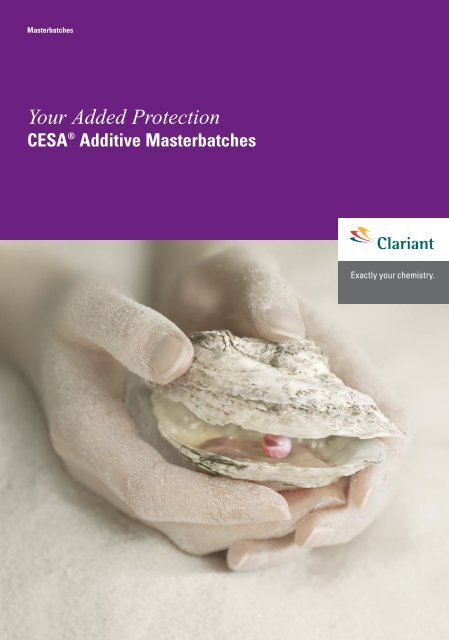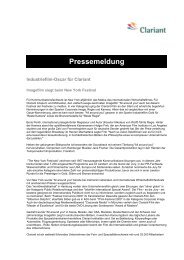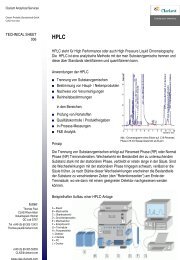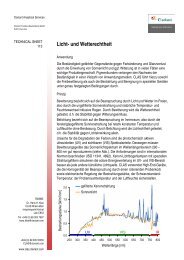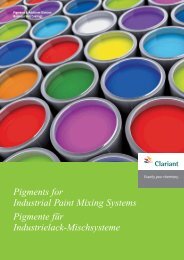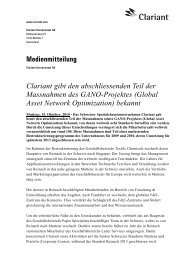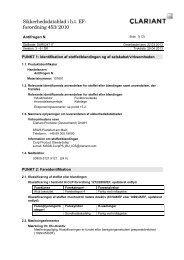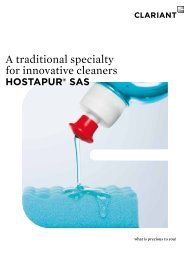CESA® Additive Masterbatches - Clariant
CESA® Additive Masterbatches - Clariant
CESA® Additive Masterbatches - Clariant
You also want an ePaper? Increase the reach of your titles
YUMPU automatically turns print PDFs into web optimized ePapers that Google loves.
<strong>Masterbatches</strong><br />
Your Added Protection<br />
CESA ® <strong>Additive</strong> <strong>Masterbatches</strong>
CESA ® <strong>Additive</strong> <strong>Masterbatches</strong><br />
UV Stabilizers . . . . . . . . . . . . . . . . . . . . . . . . . . . . . 2<br />
Flame Retardants . . . . . . . . . . . . . . . . . . . . . . . . . . 4<br />
Antistat, Antifog & Conductive . . . . . . . . . . . . . . 6<br />
Antiblock, Lubricants & Nucleating<br />
Agents. . . . . . . . . . . . . . . . . . . . . . . . . . . . . . . . . . . . 8<br />
Infrared & Corrosion Inhibitors . . . . . . . . . . . . . . 9<br />
Antimicrobials . . . . . . . . . . . . . . . . . . . . . . . . . . . 10<br />
Antioxidants . . . . . . . . . . . . . . . . . . . . . . . . . . . . . 12<br />
Drying Agents & Compatibilizers . . . . . . . . . . . 13<br />
Antislip & Fillers. . . . . . . . . . . . . . . . . . . . . . . . . . 14<br />
Processing Aids, Mold Release,<br />
Cleaning Agents & Regrind<br />
Optimization . . . . . . . . . . . . . . . . . . . . . . . . . . . . . 15<br />
Laser Marking, Phosphorescents,<br />
Optical Brighteners & Opacifiers . . . . . . . . . . . 16<br />
CESA <strong>Additive</strong> <strong>Masterbatches</strong><br />
Product Line . . . . . . . . . . . . . . . . . . . . . . . . . . . . . 17<br />
The technology leader in color and<br />
additive concentrates for plastics,<br />
<strong>Clariant</strong> <strong>Masterbatches</strong> delivers<br />
innovative performance solutions<br />
to processors, resin manufacturers<br />
and end users around the world.<br />
Specified in virtually every major<br />
market and industry, <strong>Clariant</strong>’s<br />
comprehensive line of CESA additive<br />
masterbatches offers unprecedented<br />
opportunities to improve the<br />
properties, performance and quality<br />
of finished products, while also<br />
optimizing productivity and costs.<br />
The CESA product line includes an<br />
exceptionally broad selection of<br />
standard additive masterbatches for<br />
use with all commercially available<br />
polymers. In addition, we can develop<br />
custom masterbatches as well as<br />
masterbatches combining active<br />
ingredients with selected pigments<br />
and dyestuffs, in order to meet virtually<br />
any special customer requirement.<br />
With advanced technology,<br />
unparalleled creativity and global<br />
expertise, <strong>Clariant</strong> is uniquely<br />
positioned to help our customers<br />
make their products the very best<br />
they can be. Wherever you are<br />
located, however challenging your<br />
application, you can rely on the<br />
high performance and consistent<br />
quality of CESA additive masterbatches<br />
from <strong>Clariant</strong>.
A Global Portfolio of<br />
Performance Enhancements<br />
UV Stabilizers<br />
Light radiation and oxygen in the air trigger<br />
decomposition processes in plastics that<br />
not only change their appearance, but<br />
also adversely affect their mechanical<br />
and physical properties. Light stabilizers<br />
are used to protect plastics from discoloration,<br />
embrittlement and eventual<br />
degradation caused by exposure to<br />
ultraviolet light. Applications include<br />
agricultural films, construction materials,<br />
lawn and garden equipment, signage<br />
and many other products used outdoors,<br />
as well as products exposed to fluorescent<br />
light and filtered daylight indoors.<br />
Flame Retardants<br />
Flame retardant additives make plastics<br />
safer by making them more difficult to<br />
ignite and by controlling their burning<br />
behavior. Widely used in transportation,<br />
construction, appliance and electronic<br />
applications, flame retardants help<br />
manufacturers meet UL and other regulatory<br />
requirements by minimizing flame<br />
propagation, smoke and heat generation.<br />
Antistats<br />
Antistatic agents prevent a buildup of<br />
static electricity on polymer surfaces.<br />
Static charges not only attract dust and<br />
dirt, but can also cause sheet or film<br />
to cling, stacked polystyrene cups to<br />
stick and powder to bridge. A sudden<br />
discharge can create sparks that may<br />
damage products such as computer<br />
chips and also invite risk of explosion in<br />
hazardous areas. Antistats help avoid<br />
such problems, while also improving<br />
processability and mold release.<br />
Antiblocking/Slip Agents<br />
Antiblocking and slip agents modify the<br />
surface of polymeric sheet or film, making<br />
it rougher or more slippery. They are<br />
used to prevent thin films,<br />
sheets and thermoformed<br />
articles from adhering to<br />
each other and to the<br />
metal surfaces of thermoforming<br />
equipment during<br />
processing.<br />
Antislip Agents<br />
Filled polyethylene<br />
heavy-duty bags have a<br />
tendency to slip and slide<br />
when stacked in layers,<br />
such as on pallets. The<br />
addition of antislip agents<br />
improves stackability by<br />
roughening the surface<br />
of the film, reducing its<br />
slip properties.<br />
Corrosion Inhibitors<br />
Typically added to packaging films,<br />
corrosion inhibitors protect the<br />
appearance and extend the service<br />
life of metal parts and components.<br />
Antimicrobials<br />
Without antimicrobials, bacteria and<br />
spores can grow on the surface of<br />
plastics, resulting in staining, odor and<br />
other undesirable characteristics,<br />
including premature product failure.<br />
Antimicrobials protect plastic film, fibers<br />
and molded products against bacterial<br />
growth, fungi, mold and mildew.<br />
Antioxidants<br />
Antioxidants, often called heat stabilizers,<br />
are organic substances that<br />
inhibit or retard polymer oxidation and<br />
its degrading effects. These include<br />
discoloration, change in viscosity, loss<br />
of physical properties, loss of clarity,<br />
and surface crazing or cracking.<br />
Processing Aids<br />
LLDPE, LLPDE-rich blends and metallocene<br />
resins are often extremely<br />
difficult to extrude due to severe<br />
problems with melt fracture during<br />
processing. Processing aids are<br />
designed to coat the inner surface of<br />
the extrusion die, reducing friction<br />
between the melt and the metal to<br />
facilitate processing.<br />
Laser Marking<br />
Although several laser sources<br />
are used to mark plastics, the most<br />
common is the Nd-YAG system.<br />
Extremely flexible, it works by<br />
scanning or tracing, resulting in an<br />
excellent fine and indelible print.<br />
1
UV Stabilizers<br />
Just as unprotected human skin<br />
suffers from sunburn due to<br />
excessive ultraviolet radiation,<br />
plastics are also damaged by<br />
exposure to light.<br />
CESA-light UV stabilizers provide<br />
outstanding protection against the<br />
degrading effects of sunlight, heat and<br />
oxygen on the mechanical, optical and<br />
physical performance of plastic parts.<br />
2<br />
The CESA-light product family includes<br />
three major classes of UV stabilizers:<br />
1 UV absorbers, which absorb harmful<br />
UV radiation, dissipating it as “harmless”<br />
thermal energy. Widely used in food,<br />
drug and personal care packaging, these<br />
active ingredients perform best in products<br />
with relatively thick wall sections,<br />
such as transparent blister packaging<br />
and hollow cosmetics tubes. Films,<br />
fibers and other products with thin cross<br />
sections will be afforded only limited<br />
protection by UV absorbers.<br />
2 Nickel quenchers, which take over<br />
the absorbed energy and dispose of it<br />
either as heat, or as fluorescent or<br />
phosphorescent radiation. Their action<br />
is independent of polymer thickness,<br />
and they are mainly used to stabilize<br />
pesticide-resistant agricultural films.<br />
3 Hindered amine light stabilizers<br />
(HALS), which do not absorb UV<br />
radiation, but act as radical interceptors,<br />
effectively inhibiting polymer degradation.<br />
Significant stabilization levels can<br />
be achieved at relatively low concentrations,<br />
regardless of wall thickness.<br />
Although current understanding of<br />
HALS is incomplete, it is believed that<br />
they convert nitro-oxyl free-radicals<br />
under photo-oxidative conditions and<br />
may also cause the deactivation of<br />
carbonyl groups.
HALS and UV absorbers are frequently used in combination<br />
to achieve the highest possible levels of light protection.<br />
For example, CESA-light 7105 masterbatch, developed for<br />
stabilization of shrink film, is based on HALS, UV absorbers<br />
and antioxidants.<br />
UV Transmittance Light Stabilization<br />
Another product, CESA-light NEA0050145, is a highly concentrated<br />
UV-absorber masterbatch developed for PET packaging<br />
to protect UV-sensitive ingredients in cosmetics, beverages<br />
and other products. At 0.8% dosage, it offers an optimum<br />
balance of price and performance.<br />
This test, indicating 50% retained elongation after accelerated exposure, was conducted using dosages of 1.5% and<br />
3% CESA-light 7101 in 100 µm LDPE film.<br />
3
Flame Retardants<br />
Since almost all plastics are<br />
based on hydrocarbons, they are<br />
combustible.<br />
CESA-flam flame retardant masterbatches<br />
help to protect people and<br />
property by delaying the spread of fire<br />
and toxic by-products and, in some<br />
cases, preventing ignition entirely.<br />
4<br />
Unlike reactive flame retardants, which<br />
are incorporated into the polymer<br />
molecule during polymerization, flame<br />
retardant masterbatches allow variable<br />
dosing levels and thus flexibility during<br />
processing. The effects may be either<br />
physical or chemical, occurring in<br />
either the gaseous or solid phase.
The most common flame retardants<br />
include the following:<br />
1 The effectiveness of inorganic<br />
hydroxides (such as magnesium hydroxide<br />
and aluminum trihydroxide) is based<br />
on the dilution of the plastic as a<br />
combustible material – more specifically,<br />
on the dilution of the incendiary gases<br />
and on the absorption of energy by<br />
endothermic reactions. Because of their<br />
very high dosage requirement (>50%),<br />
inorganic hydroxides are preferably<br />
used in compounding.<br />
Flame Retardancy<br />
Flame-retardant rating<br />
according to UL94 testing<br />
V-0<br />
V-1<br />
V-2<br />
non-classified<br />
0<br />
10<br />
2 Halognenated flame retardants<br />
(e.g., brominated and antimony systems)<br />
actively intervene in the free-radicalbased<br />
combustion reactions in the<br />
gaseous phase and form less reactive<br />
byproducts. This delays or interrupts<br />
auto-catalytic combustion. Highly<br />
efficient, halogenated flame retardant<br />
additives are especially suitable for<br />
manufacturing flame retardant<br />
concentrates.<br />
3 Compounds containing phosphorous,<br />
which facilitate the formation of a protective<br />
layer of carbon via the phosphoric<br />
acid produced during a fire. These have<br />
specific effects that are less universal<br />
in application.<br />
halogen-containing<br />
flame retardants<br />
halogen-free<br />
flame retardants<br />
Addition level of flame retardants (%)<br />
20 30<br />
4 Intumescent systems, which cause<br />
the formation of a protective, ceramiclike<br />
layer via a combination of active<br />
agents (organophosphorous compounds<br />
combined with a “foaming agent”).<br />
Intumescent systems also have limited<br />
applications.<br />
CESA-flam masterbatches offer a wide<br />
range of very efficient and universally<br />
usable halogenated flame retardants,<br />
as well as some specific halogen-free<br />
solutions. They are used primarily for<br />
extrusion and injection molding applications<br />
in LDPE, LLDPE, HDPE, PP, PS,<br />
ABS and engineering resins. A few<br />
CESA-flam grades have been specifically<br />
developed for fiber applications.<br />
5
Antistat, Antifog<br />
& Conductive<br />
Antistat<br />
The chemical structure of plastics<br />
makes them particularly susceptible<br />
to buildup of electrical charges,<br />
which attracts dust and accumulated<br />
static electricity. Eliminating<br />
the electric charges to maintain good<br />
product appearance is a must for<br />
successful marketing of food and<br />
cosmetics packaging. It is also critical<br />
to protect sensitive electronics<br />
packaging and to reduce a major fire<br />
hazard in production environments.<br />
6<br />
CESA-stat antistatic masterbatches<br />
are formulated for use with virtually all<br />
polymers in injection molded, blow<br />
molded and extruded applications.<br />
They are easier to disperse uniformly<br />
than antistatic agents in liquid or paste<br />
form. The active ingredients of CESAstat<br />
masterbatches can also be combined<br />
with other additives and pigments<br />
in a single easy-to-use masterbatch.<br />
Antistatic agents are additives whose<br />
efficiency is measured either by<br />
determining the surface resistivity or<br />
the static decay. Without antistatic<br />
agents, the surface resistivity of plastic<br />
is typically between 10 14 to 10 15 ohms.<br />
Antistatic additives will lower the<br />
surface resistivity to 10 9 to 10 12 ohms.<br />
In order to achieve a higher conductivity,<br />
conductive fillers such as carbon<br />
black or carbon fibers or powdered<br />
metal must be added to the plastic.
Antifog<br />
Food packaging and horticultural films<br />
used with water-containing products<br />
often fog over on their inner surface<br />
due to the condensation of tiny droplets<br />
of moisture. Droplets are particularly<br />
undesirable in greenhouse films, where<br />
good light transmission is essential for<br />
crop growth.<br />
CESA-nofog additive masterbatches<br />
eliminate the problem by lowering the<br />
surface tension of the water droplets,<br />
causing them to merge and form a<br />
Half-time charge decay (sec.)<br />
50<br />
40<br />
30<br />
20<br />
10<br />
0<br />
> 180<br />
Without<br />
additive<br />
1<br />
CESA-stat 3101 (%)<br />
1.5 2<br />
This test was conducted using CESA-stat 3101 in LDPE injection molded plaques,<br />
1 mm in thickness, 3 days after manufacture.<br />
continuous transparent layer that maintains<br />
the clarity of the film. For example,<br />
CESA-nofog 2101 was developed for<br />
LDPE and LLDPE food packaging film.<br />
It does not affect the transparency of<br />
the film and withstands sudden temperature<br />
variations.<br />
Conductive<br />
While the good insulation properties of<br />
polymers are desirable in a wide range<br />
of applications, their typically very low<br />
Charge Decay Surface Resistivity<br />
Surface resistivity (ohm)<br />
10 13<br />
10 12<br />
10 11<br />
10 10<br />
10 9<br />
3<br />
electrical conductivity sometimes<br />
restricts their area of application. The<br />
use of CESA-conductive compounds<br />
and masterbatches improves electrical<br />
conductivity, enabling plastic parts,<br />
for example, to protect highly sensitive<br />
electronic components from damage<br />
caused by electrostatic discharge.<br />
Conductive compounds are also<br />
increasingly used in components for<br />
transporting hazardous materials.<br />
4 6<br />
CESA-stat 3301 (%)<br />
1 day after production<br />
14 days after production<br />
This test was conducted using CESA-stat 3301 in 1 mm molded plaques of HIPS, at 50%<br />
relative humidity, per test method ASTM D257.<br />
7
Antiblock, Lubricants<br />
& Nucleating Agents<br />
Antiblock<br />
CESA-block antiblocking additives<br />
modify the surface characteristic by<br />
creating a slight surface roughness or<br />
smoother surface, thus reducing the<br />
coefficient of friction. This prevents<br />
self-adhesion of plastic film or sheet,<br />
making it easier to handle. Typical<br />
applications include polyolefin films<br />
and polyester sheets used in food<br />
packaging.<br />
Depending on the grade specified,<br />
CESA-block provides very good dispersion,<br />
optical properties and efficient<br />
antiblocking effects even at low dosing<br />
ratios. As an example, CESA-block 1102<br />
is a masterbatch containing effective<br />
active substances in an LDPE carrier.<br />
Its good dispersion and small particle<br />
size make it suitable for thin-gauge<br />
applications. The suggested dosage<br />
is 0.5 to 1%.<br />
Lubricants<br />
CESA-slip lubricants improve the flow<br />
characteristics of plastics during processing.<br />
They also reduce the frictional<br />
resistance of end-product surfaces,<br />
enhancing both appearance and function.<br />
In addition, CESA-slip masterbatches<br />
can act as plasticizers and impact<br />
enhancers, as well as antiblock,<br />
antitack and antistatic agents.<br />
CESA-slip can be used in conjunction<br />
with other plastics additives including<br />
release agents and heat stabilizers.<br />
For example, CESA-slip PEA0050534<br />
combines slip and antiblocking agents<br />
in an LDPE carrier material. It improves<br />
slip properties at a dosage of 1%.<br />
8<br />
Nucleating Agents<br />
CESA-nucleant masterbatches are<br />
mainly used to clarify PP resin. They<br />
influence the degree of crystallinity of<br />
polymers and increase hardness, tensile<br />
strength, modulus of elasticity and yield<br />
point, while also reducing cycle times.<br />
CESA-nucleant greatly improves optical<br />
properties such as transparency or<br />
translucency.<br />
Chemical foaming agents, materials that<br />
generate gas upon decomposition, also<br />
act as nucleating agents. The fine-grain<br />
spherulite structure of ingredients incorporated<br />
in <strong>Clariant</strong>’s HYDROCEROL ®<br />
chemical foaming agent makes it an<br />
Antiblocking Efficiency<br />
Denesting force (%)<br />
100<br />
80<br />
60<br />
40<br />
20<br />
0<br />
Without antiblocking<br />
additive<br />
ideal nucleating agent in direct gassed<br />
PS and polyolefin foams. The nucleating<br />
effect results in small cell sizes.<br />
HYDROCEROL nucleating agents are<br />
available for gassed foam extrusion in<br />
powder and masterbatch form, in various<br />
concentrations and carrier systems.<br />
The optimal dosage of HYDROCEROL<br />
nucleating agents depends on the<br />
desired foam quality and all the other<br />
variables in the process. For optimization,<br />
a starting dosage of 0.2 to 0.3%<br />
(based on active ingredient) has proven<br />
to be favorable.<br />
With CESA-block 1501<br />
additive<br />
This blocking force test was conducted using CESA-block 1501 in PET film, 300 µm thick, use levels 0 and<br />
3.5% respectively.
Infrared & Corrosion<br />
Inhibitors<br />
Infrared<br />
CESA-IR masterbatches have been<br />
developed for use in agricultural thermal<br />
films. While maintaining transparency,<br />
they allow penetration of short-wave<br />
IR radiation coming from solar rays,<br />
yet prevent the emission of longer-wave<br />
IR radiation. This increases heat<br />
retention, supports plant growth and<br />
allows greenhouses to maintain an<br />
adequate temperature, even at night.<br />
Corrosion Inhibitors<br />
CESA-cor anticorrosion concentrates<br />
are used to protect ferrous and most<br />
non-ferrous metals from the deteriorating<br />
effects of corrosion. Typical applications<br />
are films used for packaging ball bearings,<br />
automotive spare parts and other<br />
metal components.<br />
When extruding PE film with CESA-cor,<br />
the active inhibitors are vaporized and<br />
well dispersed. The film protects the<br />
packaged part by condensing on the<br />
surface of the metal.<br />
CESA-cor corrosion inhibitors are<br />
nitrite-free, have a neutral odor and<br />
produce no adverse effects on the<br />
working environment.<br />
9
Antimicrobials<br />
Microorganisms such as fungi and<br />
bacteria are present in all environments,<br />
although they are invisible to<br />
the naked eye. The reproduction and<br />
growth of bacteria, fungi, mildew and<br />
molds happen rapidly on plastic surfaces.<br />
CESA-antimicro masterbatches inhibit<br />
the growth of these microorganisms,<br />
helping to prevent unpleasant odors,<br />
discoloration, and surface degradation<br />
of plastic parts.<br />
Typical applications for antimicrobials<br />
include fibers and textiles used in<br />
athletic gear and household furnishings,<br />
kitchenware and bathroom products,<br />
automotive steering wheels and interior<br />
parts, pharmaceutical and medical<br />
products, and a spectrum of other<br />
plastic applications requiring a high<br />
standard of hygiene.<br />
10<br />
There are two major types of antimicrobials,<br />
both of which are represented in<br />
the CESA-antimicro product line. Organic<br />
antimicrobials consist of substances<br />
that migrate within the polymer matrix,<br />
spreading over the surface of the materials<br />
where their antimicrobial action<br />
has effect. Organic antimicrobials are<br />
effective at low concentrations, offering<br />
a favorable cost/performance ratio in<br />
polymers that are processed at temperatures<br />
not exceeding 250˚C (482˚F).<br />
Inorganic antimicrobials incorporate<br />
substances containing silver in ionic<br />
form, bound to inorganic compounds<br />
that regulate the diffusion of ions within<br />
the polymer mass. The silver ion is the<br />
active ingredient that interacts with<br />
bacteria. Non-toxic, non-corrosive and<br />
flameproof, inorganic antimicrobials have<br />
no negative impact on plastics processing.<br />
They are highly recommended for objects<br />
requiring long-lasting antimicrobial<br />
action and for engineering polymers that<br />
are processed at high temperatures.<br />
<strong>Clariant</strong>’s wide range of CESA-antimicro<br />
masterbatches answers every requirement<br />
regardless of the resin or process.
Antibacterial Effect on Plastic<br />
Number of bacteria<br />
4,000,000<br />
3,500,000<br />
3,000,000<br />
2,500,000<br />
2,000,000<br />
1,500,000<br />
1,000,000<br />
500,000<br />
0<br />
Start<br />
After 24 hours<br />
0 0.65 1.30 2.00 2.60<br />
Masterbatch dosage (%)<br />
Bacterial Growth on Plastic End Article<br />
Number of bacteria<br />
5,000,000<br />
4,500,000<br />
4,000,000<br />
3,500,000<br />
3,000,000<br />
2,500,000<br />
2,000,000<br />
1,500,000<br />
1,000,000<br />
500,000<br />
0<br />
8 9 10<br />
Time (hours)<br />
11 12<br />
11
Antioxidants<br />
Oxidation and heat aging are major<br />
causes of degradation of plastics.<br />
Exposure to heat and oxygen causes a<br />
chain reaction involving the formation<br />
of free-radicals, which inevitably leads<br />
to cleavage of the main chains in the<br />
polymer and degradation of the plastic.<br />
This is manifested in many different<br />
ways including loss of shine and transparency,<br />
yellowing, surface cracking<br />
and odors. Oxidation can also result in<br />
loss of mechanical properties such as<br />
impact resistance, elongation and<br />
tensile strength.<br />
CESA-nox antioxidant masterbatches<br />
are formulated to combat thermo-oxidative<br />
decomposition at every stage of the<br />
plastic life cycle, from manufacturing,<br />
drying and processing through end use.<br />
They are particularly suitable for use in<br />
LDPE, LLDPE, HDPE and PP. One example<br />
is CESA-nox 4201, a masterbatch based<br />
on a combination of antioxidants for<br />
long-term heat protection of polypropylene<br />
caused by severe outdoor and/or<br />
heat exposure.<br />
Antioxidant Efficiency<br />
5<br />
4.5<br />
4<br />
3.5<br />
3<br />
2<br />
12<br />
1<br />
without antioxidant<br />
Number of extrusions<br />
0.6% CESA-nox 4102<br />
2 3<br />
Multiple processing was performed by extrusion of LDPE at 240˚C, 0.6% CESA-nox 4102<br />
addition rate.<br />
Heat Aging Test<br />
Heat aging resistance<br />
at 150°C (days)<br />
150.0<br />
100.0<br />
50.0<br />
0.0<br />
1.2 2.5<br />
CESA-nox PP 41412 (%)<br />
Test at 150°C on 1 mm thick homopolymer PP plaques<br />
Evaluation: embrittlement time (days)<br />
5.0
Drying Agents<br />
& Compatibilizers<br />
Drying Agents<br />
CESA-dry desiccant masterbatches<br />
eliminate the need for pre-drying resin<br />
before processing, and also help to<br />
protect metal tools from oxidation.<br />
They are particularly recommended in<br />
applications where high moisture levels<br />
negatively influence processability.<br />
For example, CESA-dry MB 1, a concentrate<br />
of specific active substances in a<br />
polyethylene carrier, can be used to<br />
facilitate processing of recycled resins,<br />
resins containing biodegradable starch<br />
and other high-moisture-level polymers.<br />
It is also suitable for injection and blow<br />
molded polyolefins.<br />
Compatibilizers<br />
When resins and certain reinforcing<br />
materials are not compatible, the<br />
addition of an appropriate compatibilizing<br />
material may allow them to be blended<br />
or alloyed. CESA-mix compatibilizers<br />
bridge the gap between different resin<br />
chemistries, enabling them to form a<br />
homogeneous structure.<br />
13
Antislip & Fillers<br />
Antislip<br />
Many antislip agents consist of coarse<br />
particles that do not melt during processing.<br />
They must be large enough to<br />
protrude from the surface of the plastic<br />
film, producing a surface roughness<br />
that eliminates slippage.<br />
CESA-grip antislip agents are based<br />
on organic and inorganic, non-migrating<br />
agents that have no adverse effect on<br />
screw wear. They are recommended to<br />
create a sandpaper-like surface modification<br />
of thick films (>80 to 100 microns).<br />
As an example, CESA-grip 9101 masterbatch<br />
is used for the production of film<br />
for heavy-duty bags. It produces a rough<br />
surface yet does not contain abrasive<br />
components. The suggested dosage is<br />
1.5 to 2.5%.<br />
14<br />
Filler<br />
CESA-fill masterbatches increase the<br />
bulk of compounds, reducing their cost.<br />
Their excellent polymer adhesion helps<br />
to improve part stiffness, hardness,<br />
thermal stability, flame retardancy and<br />
dimensional stability.
Processing Aids, Mold Release,<br />
Cleaning Agents & Regrind Optimization<br />
Processing Aids<br />
During the extrusion process, CESAprocess<br />
masterbatches coat the inner<br />
surface of the die, reducing the friction<br />
between the melt and the metal and<br />
allowing polymers to extrude more<br />
easily. By lowering the friction and<br />
eliminating or reducing melt-fracture<br />
and die buildup, CESA-process enables<br />
difficult-to-process materials such as<br />
narrow-molecular-weight LLDPE and<br />
LLDPE-rich blends to run on existing<br />
extrusion lines.<br />
An example is CESA-process AEH603, a<br />
masterbatch based on fluoroelastomers.<br />
Developed for LLDPE and metallocene<br />
film extrusion, it can be used in conjunction<br />
with high quantities of fillers,<br />
antiblocking agents and inorganic<br />
pigments. In addition to eliminating<br />
melt-fracture and reducing die buildup,<br />
the use of this masterbatch enhances<br />
the optical properties of the film by<br />
improving its transparency.<br />
Mold Release<br />
The addition of CESA-release masterbatches<br />
to polymers during processing<br />
prevents parts from sticking to the mold<br />
cavity, facilitating their removal. Other<br />
advantages include reduced cycle times<br />
and increased machine output.<br />
Cleaning Agents<br />
Plastics processing periodically requires<br />
complete removal of thermo-oxidized<br />
deposits from extruders and injection<br />
molding machines. CESA-clean<br />
masterbatches permit fast, economical<br />
cleaning of machinery to facilitate color<br />
or resin changes with minimal downtime<br />
and loss of virgin material.<br />
One example is CESA-clean 9104<br />
masterbatch, a balanced mixture of<br />
surface-active substances and fillers<br />
with a low abrasive power, based on<br />
low-density polyethylene. Widely used<br />
for purging extruders and injection<br />
presses, the masterbatch allows quick<br />
changes of color and materials of<br />
varying viscosities.<br />
Regrind Optimization<br />
Re-using post-industrial or post-consumer<br />
polyester regrind has typically<br />
been limited due to the adverse effects<br />
of heat and moisture on the virgin resin.<br />
CESA-extend masterbatches utilize<br />
an oligomeric reactant to repair the<br />
damage and restore the resin’s Intrinsic<br />
Viscosity (IV). Processors can then use<br />
higher proportions of recycled resin<br />
while maintaining the same processing<br />
properties as virgin PET.<br />
A series of CESA-extend masterbatches<br />
with a variety of carrier resins is available<br />
for clear and opaque applications.<br />
These include extruded polyester sheet<br />
and strapping, stretch blow-molded<br />
PET bottles, foamed PET sheet or film<br />
and pelletizing undried recycle or scrap.<br />
15
Laser Marking, Phosphorescents,<br />
Optical Brighteners & Opacifiers<br />
Laser Marking<br />
Laser marking utilizes the energy of a<br />
highly focused laser beam to produce<br />
a combined thermal and photochemical<br />
effect. PVC, polyolefins and other polymers<br />
that are highly sensitive to laser<br />
radiation require special additives to<br />
make laser marking viable. CESA-laser<br />
masterbatches provide an effective<br />
solution. They also extend the limits of<br />
the technology by making it possible to<br />
mark in colors in addition to traditional<br />
gray tones.<br />
Phosphorescents<br />
Phosphorescent pigments are<br />
characterized by their ability to absorb<br />
and store the energy of natural or<br />
artificial light, and then emit this energy<br />
in the form of visible light in the dark.<br />
CESA-lux masterbatches enable<br />
molders to produce glow-in-the-dark<br />
extruded or molded articles.<br />
Optical Brighteners<br />
Often a brilliant appearance with a<br />
bluish undertone is desirable for<br />
thermoplastic articles, particularly for<br />
polymers with an inherently slightly<br />
yellow cast. Topical optical brighteners<br />
have typically been used to improve the<br />
surface whiteness of plastic articles<br />
and synthetic fibers.<br />
Adding CESA-bright concentrates to<br />
the polymer itself produces much better<br />
brightness retention over time than<br />
surface treatment with topical optical<br />
brighteners. CESA-bright masterbatches<br />
convert UV radiation into visible, bluish<br />
light, improving the long-term appearance<br />
of finished products.<br />
16<br />
Matting Agents & Opacifiers<br />
CESA-mat masterbatches contain<br />
application-specific additives to modify<br />
the surface properties of plastic products.<br />
They reduce gloss, giving a matte<br />
or frost-like effect to PET sheets and<br />
bottles, polyolefin films and a wide<br />
range of other products. They also are<br />
used to impart whiteness and opacity<br />
to plastic products, enhancing their<br />
appearance by light diffusion.<br />
Available in a number of different<br />
carriers ranging from polyolefins and<br />
styrenics to engineering resins, CESAmat<br />
masterbatches are suitable for use<br />
in injection and blow molding, film and<br />
sheet extrusion and other processes.<br />
One application example is CESA-mat<br />
NEA00500116 opacifier, used to obtain<br />
eye-catching aesthetic effects in PET<br />
bottles. Dosing level is 1.5 to 3.0%,<br />
depending on the desired effect.
CESA <strong>Additive</strong> <strong>Masterbatches</strong><br />
Product Line<br />
<strong>Clariant</strong> provides a diverse and comprehensive<br />
range of additive masterbatches from UV stabilizers<br />
and flame retardants to antistats, antioxidants and<br />
antimicrobials.<br />
UV Stabilizers<br />
PE PP PS PET<br />
Dosage Stretch Shrink Injection Spin Injection Injection Injection<br />
CESA-light Rate % Film Film Molding Dyeing Extrusion Extrusion Extrusion<br />
7101 1.5-3 ▲ ◆ ▲ ◆<br />
7102 0.75-2 ▲ ▲ ◆<br />
7103 0.5-3 ▲ ◆ ▲ ◆<br />
7104 1-3 ▲<br />
7105 1.5-2.5 ▲<br />
7201 0.5-4 ▲ ◆<br />
7202 0.5-4 ▲ ◆<br />
7301 1.5-3 ▲<br />
7501 1-3 ▲<br />
Flame Retardants<br />
PE PP ABS<br />
Dosage Film Injection Injection Injection<br />
CESA-flam Rate % Extrusion Molding Extrusion Extrusion<br />
5101 3-20 ▲ ◆<br />
5102 3-3.5 ▲<br />
5201 3-20 ▲<br />
5401 20 ▲<br />
Antistats<br />
LDPE-LLDPE HDPE EVA PP PS ABS<br />
Injection Film & Injection Injection Injection<br />
Dosage Film Injection Film & Blow Injection Molding & Molding & Molding &<br />
CESA-stat Rate % Extrusion Molding Extrusion Molding Molding Extrusion Extrusion Extrusion<br />
3101 0.5-3.5 ▲ ◆ ▲ ▲ ▲ ◆<br />
3102 0.2-1 ◆ ◆ ▲ ◆ ▲<br />
3103 0.5-3 ▲ ◆ ◆ ▲ ▲ ◆<br />
3104 1.5-5 ▲ ◆ ◆<br />
3105 0.8-1.5 ◆ ◆ ◆ ◆ ▲<br />
3301 4-6 ▲ ◆<br />
Antifogging Agent<br />
LDPE LLDPE<br />
Dosage Packaging Film Packaging Film<br />
CESA-nofog Rate % Extrusion Extrusion<br />
2101 4-5 ▲ ▲<br />
Antiblocking Agents<br />
LDPE EVA PP PET PETG<br />
Film Film<br />
Dosage Extrusion Extrusion Film Film<br />
CESA-block Rate % >30 micron
GLOBAL HEADQUARTERS<br />
<strong>Clariant</strong> International Ltd<br />
<strong>Masterbatches</strong> Division<br />
Rothausstrasse 61<br />
CH-4132 Muttenz 1<br />
Switzerland<br />
Tel: +41 61 469 6170<br />
Fax: +41 61 469 6597<br />
REGIONAL HEADQUARTERS<br />
North America<br />
<strong>Clariant</strong> <strong>Masterbatches</strong><br />
85 Industrial Drive<br />
Holden, MA 01520, USA<br />
Tel: +1 888 621 1282<br />
Tel: +1 508 829 6321<br />
Fax: +1 508 829 7887<br />
Latin America<br />
<strong>Clariant</strong> (Brazil) S.A.<br />
Av. Nações Unidas 18.001<br />
04795-900 Santo Amaro<br />
São Paulo, Brazil<br />
Tel: +55 11 5683 7848<br />
Fax: +55 11 5683 7808<br />
Asia/Pacific<br />
<strong>Clariant</strong> <strong>Masterbatches</strong><br />
(Thailand) Ltd.<br />
31 Rama III Road<br />
Chongnonsri, Yannawa<br />
Bangkok 10120, Thailand<br />
Tel: +66 2 294 0350<br />
Fax: +66 2 294 1103<br />
Europe<br />
North<br />
<strong>Clariant</strong> Masterbatch GmbH<br />
& Co. OHG<br />
Hohenrhein 1<br />
D-56112 Lahnstein, Germany<br />
Tel: +49 2621 14 222<br />
Fax: +49 2621 14 245<br />
South<br />
<strong>Clariant</strong> (Italia) S.p.A.<br />
Via Lainate, 26<br />
I-20010 Pogliano Milanese (MI), Italy<br />
Tel: +39 02 99187558<br />
Fax: +39 02 99187552<br />
West<br />
<strong>Clariant</strong> (France) S.A.<br />
5, rue des Closeaux<br />
Boîte Postale 1538<br />
F-78205 Mantes la Jolie Cedex, France<br />
Tel: +33 1 3094 0198<br />
Fax: +33 1 3094 2796<br />
www.clariant.masterbatches.com<br />
MB 1076 5.05<br />
A Partner in Innovation<br />
A global color technology<br />
leader, <strong>Clariant</strong> offers the<br />
industry’s broadest range of<br />
high-performance masterbatches<br />
for plastics, including<br />
CESA ® additive masterbatches;<br />
RENOL ® masterbatches<br />
for engineering<br />
resins, styrenics and PVC;<br />
REMAFIN ® masterbatches<br />
for polyolefins; OMNICOLOR ®<br />
universal color masterbatches;<br />
HYDROCEROL ®<br />
chemical foaming and<br />
nucleating agents; and<br />
ENIGMA special effects.<br />
These products are widely<br />
specified in the packaging,<br />
automotive, durable goods,<br />
housewares, office automation,<br />
electrical, and other<br />
major industries.<br />
<strong>Clariant</strong>’s in-depth market<br />
knowledge, formulation<br />
expertise and customer<br />
commitment are recognized<br />
worldwide. A global network<br />
of ISO 9000 facilities incorporates<br />
the most demanding<br />
manufacturing standards to<br />
ensure the quality and<br />
consistency of <strong>Clariant</strong><br />
masterbatches wherever<br />
they are used.<br />
<strong>Clariant</strong> also continues to<br />
drive new dimensions in<br />
color creativity. At its global<br />
ColorWorks Design<br />
and Technology Centers,<br />
inspiration and technology<br />
meld together, helping<br />
customers strengthen brand<br />
recognition, enhance new<br />
product development and<br />
accelerate speed<br />
to market.<br />
Additional information about<br />
<strong>Clariant</strong> products and technical<br />
support is available<br />
from all our global facilities.<br />
Start a dialog with the<br />
experts at the <strong>Clariant</strong><br />
location nearest you.<br />
The information in this publication corresponds to the present state of our knowledge and is intended to describe our products and their general<br />
possible applications. Because conditions of use are outside our control, <strong>Clariant</strong> makes no warranties, express or implied, and assumes<br />
no liability in connection with any use of this information. Any existing intellectual/ industrial property rights must be observed. Quality is<br />
guaranteed in accordance with our general conditions of sale. For additional information, please contact your <strong>Clariant</strong> representative.<br />
® CESA, OMNICOLOR, REMAFIN, RENOL and HYDROCEROL are registered trademarks of <strong>Clariant</strong>.<br />
ColorWorks and ENIGMA are trademarks of <strong>Clariant</strong>.<br />
© 2005 <strong>Clariant</strong> Corporation. Printed in USA.


